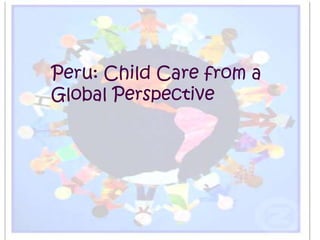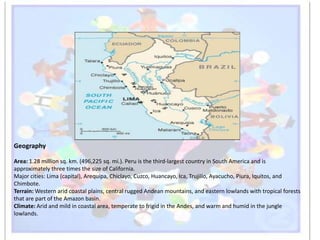Peru presentation
- 1. Peru: Child Care from a Global Perspective
- 3. Geography Area: 1.28 million sq. km. (496,225 sq. mi.). Peru is the third-largest country in South America and is approximately three times the size of California. Major cities: Lima (capital), Arequipa, Chiclayo, Cuzco, Huancayo, Ica, Trujillo, Ayacucho, Piura, Iquitos, and Chimbote. Terrain: Western arid coastal plains, central rugged Andean mountains, and eastern lowlands with tropical forests that are part of the Amazon basin. Climate: Arid and mild in coastal area, temperate to frigid in the Andes, and warm and humid in the jungle lowlands.
- 4. People Nationality: Peruvian. Ethnic groups: Indigenous (45%); mixed background ("mestizo") (37%); European (15%); African, Japanese, Chinese, and other (3%). Population (2009): 29.11 million. Approximately 30% of the population lives in the Lima/Callao metropolitan area. Annual population growth rate (2009): 1.11%. Religions: Roman Catholic (81%), other (10%). Languages: Spanish is the principal language. Quechua, Aymara and other indigenous languages also have official status. Education: Years compulsory--11. Attendance--ages 6-11, 92%; ages 12-16, 66%. Literacy--96% in urban areas, 80% in rural areas. Health: Infant mortality rate (2006)--29.96 per 1,000. Life expectancy (2007)--68.33 years male; 72.04 years female. Unemployment in Lima (2009): 8.4%; underemployment (2009): 44.66%
- 5. Languages Spanish & Quechua Are Peru’s official languages
- 6. There are only eight known people left on the earth that speak the language of Chamicuro. And they all live near the Andes of Peru. Here are some ways to say animal names in Chamicuro: Horse = Kawali Monkey = Katuikana Chicken = Polyo Duck = Pato Dog =Ma’nali Cow = Waka Cat = Mishi
- 7. History of the Day Care In Peru “Day Care/Pre School, Toddlers, and Nursery Schools as well as Pre Kindergarten and Kindergarten” starts and begins in Elementary school There are schools that offer bilingual education in English and Spanish Nursery schools begin at the age of (3 years old) In Peru, the school year is from March-December and summer holiday is January to the middle of March. Students also get 2 weeks of vacation in August
- 8. Preschool/Daycare is Peru began in 1975 but before that it was not recognized Reggio Emila Pre-schools/Daycare came to Peru in 1999 After 1975 other preschools around Peru were opening up and preschool/daycare was being recognized and placed into schools Child would actually start elementary school at 3 years of age and continue right up until grade 11.
- 9. Types of Daycare Childcare programs are the neediest projects in Peru The government started to invest in early education and childcare in 2001 The program was called The Project for Integrated Services to Children Less than Six Years in the Rural Mountainous Region However, the program lost its funding and was shut down in 2004
- 10. Most childcare centres are very informal places that depend on many volunteers from around the world The children in these places require a lot of care, attention and companionship These volunteers assist with organizing activities for the children as well as helping them with their school work Many of these childcare projects are disorganized, understaffed and underfunded
- 11. In comparing formal and informal preschool programs, there were reported differences in the language and mathematics outcomes of the two groups of children The children who attended the formal preschools did better
- 13. Most recently, Peru has recently adopted a policy for the development of early childcare programs which supports the work of the country’s Non- Formal Program for Initial Education This policy makes it compulsory for children’s education to begin at the age of three Peru’s Laws of Childhood ensures that the State’s responsibility for children with disability include education Even though programs have positive evaluations, they struggle to survive because of lack of funding
- 14. Bibliography • Images • http://www.flagpictures.tk/wp-content/uploads/pictures/pictures-of-peru-flag-438.jpg • http://www.ayllusuyu.com/gallery/children/peru_child4.jpg • http://definitelyfilipino.com/blog/wp-content/uploads/2010/09/talking-cartoon.gif • http://www.inspirationalspaces.com.au/attachments/Image/web_Ann_with_Peru_child.jpg • http://www.state.gov/r/pa/ei/bgn/35762.htm
- 15. The Danger of Poor Day Care Centres This video shows the consequence of having little money for daycare centres in poor regions. http://www.youtube.com/watch?v=T01sRejSj5 8&feature=related















